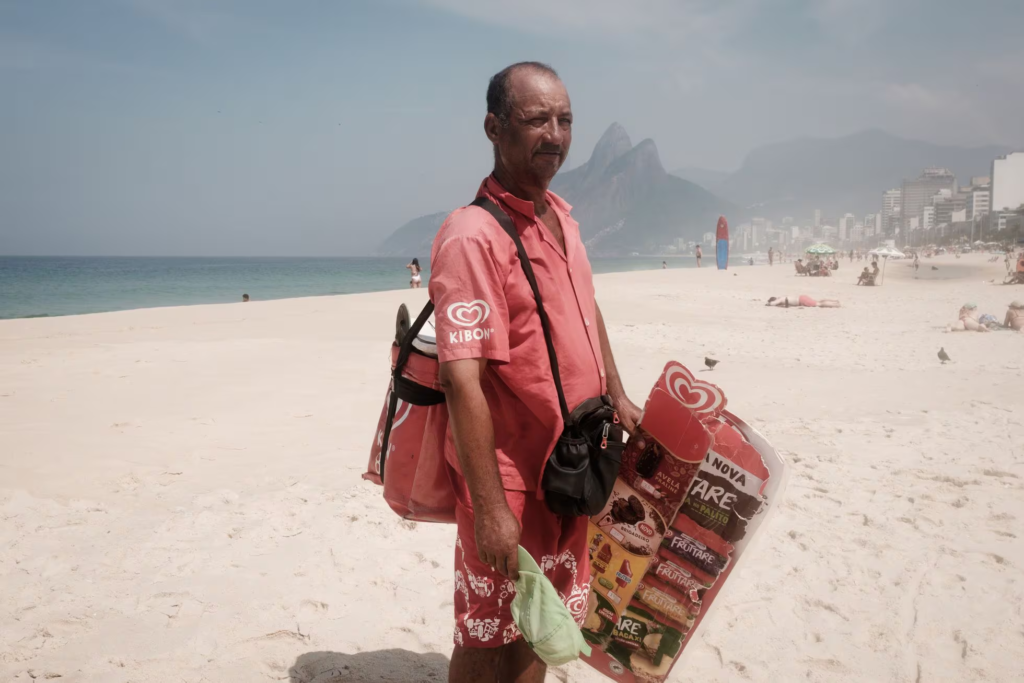The main purpose of this ongoing blog will be to track planetary extreme, or record temperatures related to climate change. Any reports I see of ETs will be listed below the main topic of the day. I’ll refer to extreme or record temperatures as ETs (not extraterrestrials).😉
Main Topic: Heat Index Hits 144°F/62°C at Rio De Janeiro
Dear Diary. Like Brad Friedman from Progressive Voices, who quipped on yesterday’s Green News Report, Ouch!, I can’t imagine experiencing 144°F/62°C except briefly in a sauna. Science has suggested that people can’t survive too long outside without water when wet bulb temperatures are above 95°F/35°C, or readings just below body temperature, so I imagine that there were many health problems at Rio De Janeiro when heat index readings got as high as 62°C/144°F. Rio’s recent heat is part of an overall South American heatwave that has been brought about by our warming climate due to carbon pollution.
So, what exactly is the heat index? Here is that answer from the National Weather Service:
What is the heat index? (weather.gov)
“It’s not the heat, it’s the humidity”. That’s a partly valid phrase you may have heard in the summer, but it’s actually both. The heat index, also known as the apparent temperature, is what the temperature feels like to the human body when relative humidity is combined with the air temperature. This has important considerations for the human body’s comfort. When the body gets too hot, it begins to perspire or sweat to cool itself off. If the perspiration is not able to evaporate, the body cannot regulate its temperature. Evaporation is a cooling process. When perspiration is evaporated off the body, it effectively reduces the body’s temperature. When the atmospheric moisture content (i.e. relative humidity) is high, the rate of evaporation from the body decreases. In other words, the human body feels warmer in humid conditions. The opposite is true when the relative humidity decreases because the rate of perspiration increases. The body actually feels cooler in arid conditions. There is direct relationship between the air temperature and relative humidity and the heat index, meaning as the air temperature and relative humidity increase (decrease), the heat index increases (decreases).

| Figure 1. Heat index chart. |
| In order to determine the heat index using the chart above, you need to know the air temperature and the relative humidity. For example, if the air temperature is 100°F and the relative humidity is 55%, the heat index will be 124°F. When the relative humidity is low, the apparent temperature can actually be lower than the air temperature. For example, if the air temperature is 100°F and the relative humidity is 15%, the heat index is 96°F (use this calculator). In the Panhandles, we commonly see hot temperatures during the summer, but the low relative humidity values make it somewhat unusual to see dangerous heat index values (i.e. 103°F or greater). A full heat index chart for a larger range of temperatures and relative humidity values can be found at this link. |
| It surprises many people to learn that the heat index values in the chart above are for shady locations. If you are exposed to direct sunlight, the heat index value can be increased by up to 15°F. As shown in the table below, heat indices meeting or exceeding 103°F can lead to dangerous heat disorders with prolonged exposure and/or physical activity in the heat. |
| Classification | Heat Index | Effect on the body |
| Caution | 80°F – 90°F | Fatigue possible with prolonged exposure and/or physical activity |
| Extreme Caution | 90°F – 103°F | Heat stroke, heat cramps, or heat exhaustion possible with prolonged exposure and/or physical activity |
| Danger | 103°F – 124°F | Heat cramps or heat exhaustion likely, and heat stroke possible with prolonged exposure and/or physical activity |
| Extreme Danger | 125°F or higher | Heat stroke highly likely |
Use this weather calculator if you prefer to enter numbers manually instead of reading a chart. If you’re really mathematically inclined, there is an equation that gives a very close approximation to the heat index. However, this equation was obtained using a multiple regression analysis, and therefore, it has an error of ±1.3°F.
Heat Index = -42.379 + 2.04901523T + 10.14333127R – 0.22475541TR – 6.83783 x 10-3T2 – 5.481717 x 10-2R2 + 1.22874 x 10-3T2R + 8.5282 x 10-4TR2 – 1.99 x 10-6T2R2
T – air temperature (F)
R – relative humidity (percentage)
Notice that 144°F is literally off the National Weather Service Chart. Ouch!
Here are more details from El Pais:
Six records and a 144.1ºF heat index: The beaches of Rio de Janeiro are burning
The Brazilian city recorded the highest temperature of the decade on Saturday at 9:55 a.m., fueled by humidity and geographical factors such as the nearby mountains

Bathers cool off after another hot day on Ipanema beach, in Rio (Brazil), on Wednesday. LEONARDO CARRATO
When the heat hits, the beaches of Rio de Janeiro are a refuge for tens of thousands of city residents and tourists. Last Saturday, the city broke all historical records, registering a heat index of 62.3ºC (144.1ºF), according to the Rio Alert weather system. On holidays like this, the images of the beach packed with sun umbrellas are a summer classic, but behind those scenes of relief there is an army of tireless and long-suffering workers: street vendors, a symbol of Rio’s beaches and the hardest-hit by the heat waves.
They are people like André Luis Soares, who since 1994 has walked through the crowded beaches selling ice cream. “The last two years have been too hard. This past weekend, there were people who even fainted in the sand. I got a little dizzy myself, but since I have experience, I wet my head, drank some coconut water and recovered immediately,” he says during a break on Ipanema beach. Every morning he travels by train and bus the 19 miles that separate the suburban neighborhood where he lives from the acclaimed promenade and coconut trees. Once in the sand, he walks up to nine miles each day in the sun, going back and forth several times until he sells as many products as possible. Like him, there are more than 2,200 informal workers, according to city council calculations. They are people who do not pay social security contribution, who get by with what they sell each day and who, of course, cannot ask for a day off if they get sick.

André Luis Soares, an ice cream vendor, on Ipanema beach. LEONARDO CARRATO
And the risk is increasing. According to the Rio Alert weather system, this summer was the hottest in the last decade. Six temperature records were broken within a few weeks of each other: each heat wave was worse than the last. Last week’s heat wave took the cake, just over 40ºC (104ºF) on the thermometers, but up to 62.3ºC (144.1ºF) on the heat index, which measures what a temperature feels like by taking into account humidity. In Rio, humidity can reach up to 80%, making the temperature feel much hotter.
Even so, it must be pointed out that the heat is not felt equally throughout the city. The record-high temperature was recorded in Barra de Guaratiba, a neighborhood on the outskirts where winds from the northern quadrant usually blow early in the morning, heating the atmosphere even more. The geography of Rio has a lot to do with the record-breaking heat, as Climatempo meteorologist Guilherme Borges explained to the newspaper O Globo: “The mountains of the state, together with those of the state of Minas Gerais, make it difficult for wind to circulate. High humidity, which comes from proximity to the ocean, also helps to maintain higher temperatures.” Climate change is making heat waves more frequent and more intense, and this year, the situation was worsened by El Niño, the natural phenomenon that heats up the southern region.
On the beach, the most veteran workers like André Luis have cracked skin and don’t care much about sun protection; a light shirt, a cap and that’s it. Among the youngest, there is more awareness. Maria Aparecida Souza sells bikinis that hang on a heavy umbrella that she carries on her shoulders for hours. Although the bikinis she sells cover the bare minimum, she herself is covered from head to toe: cap, hat, long-sleeved sun protection shirt, gloves and shoes. “It’s because of the skin cancer,” she explains, smiling. All street vendors agree that the most important thing is to drink a lot of water and that feet, which are largely forgotten, are the most sensitive to the heat. The sand burns.

Sellers of traditional bikinis prepare to start their workday on Wednesday. LEONARDO CARRATO
Tatiana Von Korsh, who works in a stand renting umbrellas and chairs to bathers, confirms this. Recently, she had to stay home for two days and apply ointment to her feet, which were burned raw. “Look at this whole expanse of sand, all day going up and down. It is very tiring, especially with a 40-degree sun bearing down on your head,” she explains.
In the stand next door, José Rosas — who defines himself as an optimist by nature — trusts that the heat waves will at least help governments address climate change. “The trend is for it to get worse, people have to become aware of how serious excess heat is. People in Rio like the heat, their life is the heat, but many people are already fleeing, because it is too much,” he says. Despite having been a summer of record-high temperatures, most sellers complain that it was a bad season for sales.

Tatiana Von Korsh, owner of one of the beach stalls in Ipanema. LEONARDO CARRATO
In the 1990s, when André Luis began to cross the sands of Ipanema with his ice creams, one of the biggest hits in Brazil was the song Rio 40 graus, where singer Fernanda Abreu glorified the “beauty and chaos” of the “hot-blooded city.” The 40ºC heat remained in the popular imagination and even today it is printed on everything from T-shirts to the names of bars and advertising agencies, but at this rate it will soon become obsolete. The southern summer said goodbye in style, with a historic heat wave, but the first big warning came in spring.
In November, the heat index reached 58ºC (136ºF). Around that time, Taylor Swift played in town. At one of her concerts, hundreds of people fainted due to dehydration and a 23-year-old girl died from cardiac arrest caused by the extreme heat. Since then, the Brazilian government has forced event producers to hand out free water on days of extreme heat and the Rio city council has started taking into account the temperature as a factor to raise the city’s alert system.

José Rosa puts out sun chairs and umbrellas, in addition to selling products in one of the beach shops.LEONARDO CARRATO
Sign up for our weekly newsletter to get more English-language news coverage from EL PAÍS USA Edition
Here are more “ET’s” recorded from around the planet the last couple of days, their consequences, and some extreme temperature outlooks, as well as any extreme precipitation reports:
Here is more February 2024 climatology:
Here is More Climate News from Friday:
(As usual, this will be a fluid post in which more information gets added during the day as it crosses my radar, crediting all who have put it on-line. Items will be archived on this site for posterity. In most instances click on the pictures of each tweet to see each article. The most noteworthy items will be listed first.)